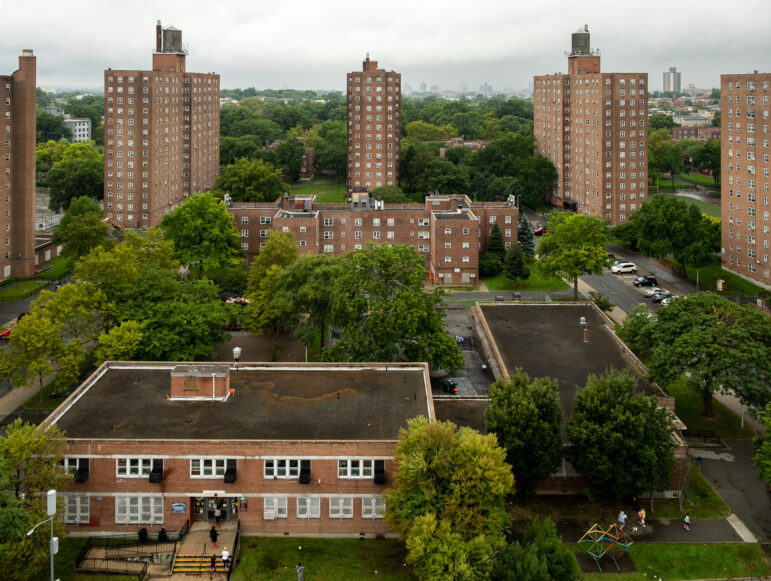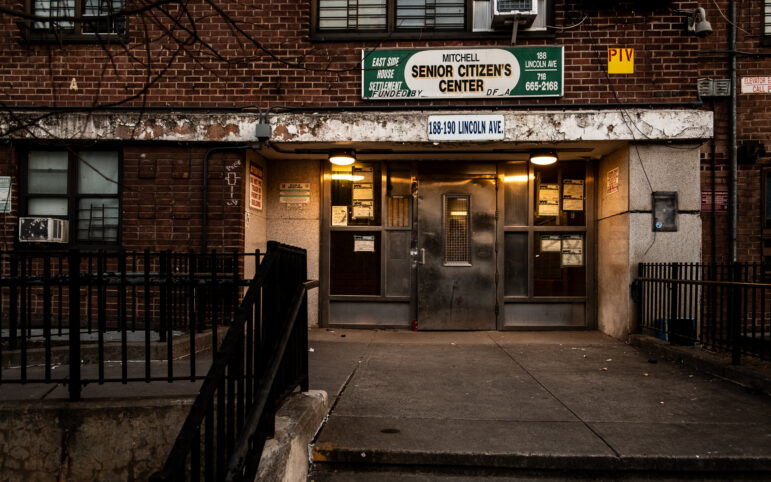A hearing held by the City Council’s public housing committee Tuesday explored various aspects of NYCHA’s finances, as the authority struggles with declining rent revenue and an uptick in vacant apartments.

Adi Talwar
Looking South West into NYCHA’s Edenwald Houses campus from near East 229th Street in the Bronx.Since the state lifted its eviction moratorium in January 2022, there have been 110 completed evictions in the New York City Housing Authority, NYCHA Chief Executive Officer Lisa Bova-Hiatt told city lawmakers Tuesday.
NYCHA carried out two evictions in 2022, 58 in 2023 and 50 so far this year, as of March 7 (another 34 evictions took place at public housing campuses that have converted to private management, news site The City reported this week).
At the start of the pandemic in March of 2020, there were 34,000 NYCHA cases pending in housing court, but 31,000 of them were wiped out during the state’s eviction moratorium, according to the CEO. In 2023, NYCHA pursued 2,307 eviction filings—1,835 nonpayment cases and 472 holdover cases which included a population of unauthorized occupants or “squatters,” according to Bova-Hiatt.
A majority of NYCHA’s evictions were for nonpayment of rent, she said.
“NYCHA’s goal is to keep residents housed and to resolve tenant issues, not to evict,” said Bova-Hiatt. “We’re focused right now on residents with the highest amount of arrears for the longest amount of time.”
Her testimony was part of a preliminary budget hearing held by the City Council’s public housing committee Tuesday exploring various aspects of NYCHA’s finances, as the authority struggles with declining rent revenue and an uptick in vacant apartments across its more than 300 developments.
About 70,000 NYCHA households now owe back rent, though total arrears went from $501 million in 2023 to $482 million as of Feb. 29, attributed in part by Bova-Hiatt to the state-funded Emergency Rental Assistance Program (ERAP).
Though public housing tenants were left out of earlier versions of the program, last year’s state budget provided additional funds. To date, NYCHA received $136 million from ERAP and $90 million has been applied to residents’ accounts, though some tenants who received help may have an outstanding balance even after aid.
“They’re finding out what the balance is that they owe because as we know, ERAP did not cover all of the arrears,” said Bova-Hiatt. “We are working with them with the balance that they do have to enter into a payment plan.”
Roughly 33,000 NYCHA households applied for the emergency rental funding, fewer than half of the households that currently owe rent.
“During the pandemic, too many tenants facing hardships couldn’t obtain rent adjustments from the property management office and were otherwise discouraged from applying for the state ERAP rental assistance,” said Ross Joy, director of housing and civil justice for the Center of Court Innovation.
The housing authority is working with the New York City Human Resources Administration (HRA) to provide emergency grant payments or one shot deals for tenants who are struggling.
“They created a dedicated NYCHA team to handle expedited one-shot deals for our residents, ensuring low-income households receive the support services to which they’re entitled,” said Bova Hiatt.
Joy, whose organization works with public housing residents, noted that some NYCHA tenants withhold rent as a means to leverage fixes for poor conditions in their homes or buildings.
“Many tenants are rightfully protesting with their pocketbooks, withholding rent for uninhabitable conditions and utility outages,” he testified to lawmakers.
NYCHA is currently only collecting 60 percent of rent from tenants, officials said, despite Department of Housing and Urban Development (HUD) rules that require housing authorities to collect 100 percent.
Bova-Hiatt said the housing authority is expected to collect $959 million in rent this year, $117 million less than what the authority should be collecting.
Rent collection accounts for one-third of NYCHA’s operational budget, and helps fund maintenance work such as painting and plastering to ready new units for the next occupant.
However, needed repairs have often proven to be more complex, involving lead abatement and removal measures, officials have said.

Adi Talwar
Entrance to NYCHA’s Mitchel Senior Citizens Apartment Building located at 188-190 Lincoln Ave in the Bronx.As of Tuesday, NYCHA was home to approximately 5,100 vacant units, according to Chief Operating Officer Eva Trimble. That’s up from 3,300 in December 2022, City Council records show.
The average estimated cost for NYCHA to turn around a vacant unit for the next tenant is $43,000, according to NYCHA.
The authority has been working with the Office of Management and Budget (OMB) on the Vacant Unit Readiness program, a city-funded initiative used to hire third-party vendors who can make the necessary fixes to get an apartment turnkey ready.
It took an average of 415 days for NYCHA to repair vacant units for re-rental during June through October 2023, according to the Mayor’s Preliminary Management Report.
“We are working as expeditiously as possible within our funding sources…we have other constraints besides funding in addition to staffing and supplies and materials,” said Trimble.
The housing authority is anticipating a year-end deficit of $35 million for calendar year 2024, according to Bova-Hiatt.
“We believe we can close this gap,” said Bova-Hiatt. “We will continue to closely monitor our spending and implement cost saving measures as we did to close the budget gap in 2023.”
But, she added,“With the increasing needs and expected growing losses in rent revenue, the annual deficit is expected to persist in the coming years.”
Chief Financial Officer and Executive Vice President of Finance Annika Lescott-Martinez projected a year-end deficit of $54 million in 2025 and $64 million in 2026, before beginning to stabilize in 2027.
The housing authority has been pursuing two alternative funding models to unlock repair money: the Public Housing Preservation Trust—which would use bonds and mortgages to fund repairs—and the Permanent Affordability Commitment Together (PACT) program, which allows private developers and management companies to maintain NYCHA properties.
When a NYCHA development transfers over to PACT, Lescott-Martinez explained, the new private management team adopts the outstanding rent arrears and pays the housing authority the amount tenants owed at the time of the conversion.
“Most times we get as close to one-for-one as we can,” Lescott-Martinez said. “So for example if there’s $100 million in arrears, we may get $90 million for those arrears—they’re no longer on our books.”
To reach the reporter behind this story, contact Tatyana@citylimits.flywheelstaging.com. To reach the editor, contact Jeanmarie@citylimits.flywheelstaging.com
Want to republish this story? Find City Limits’ reprint policy here.








